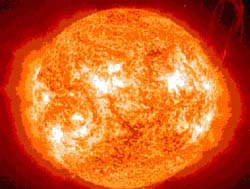

The Sun is not as quiet as it looks: the eruptions, including solar flares and corona mass ejections, occur frequently and periodically, which may bring a disaster influence on the Earth. To explore the nature of these eruptions is the task of SMESE.
The Sun is not as quiet as it looks: its eruptions, including solar flares and corona mass ejections that occur frequently and periodically, may bring about a disastrous impact on the Earth. It can influence the performance and reliability of space-borne and ground-based technological systems and can endanger human life or health. To get a better understanding of this fire ball, a group of Chinese and French astronomers have joined hands to start a micro-satellite mission recently.
The Small Explorer for the Study of Solar Eruptions (SMESE), a Chinese-French micro-satellite mission to make explorations in the field of solar physics, was jointly proposed by French and Chinese scientists in 2004. After over one-year preparations and evaluations, the official kick-off meeting for SMESE was held at the headquarters of the French Space Agency (CNES) in Paris from March 22 to 24, 2006, marking the formal initiation of its phase-A study.
The main scientific objective of SMESE is to observe two most eruptive phenomena on the Sun -- solar flares and coronal mass ejections (CMEs) for the next peak of solar activity predicted to occur during the period from 2010 to 2013, explains Prof. Gan Weiqun, a Chinese collaborator of the project and vice director of the CAS Purple Mountain Observatory (PMO).
According to Prof. Gan, three instrument packages will be onboard the micro-satellite: LYOT, DESIR, and HEBS. LYOT is composed of a Lyman alpha (121.6 nm) coronagraph, a Lyman alpha disk imager, and a far UV disk imager. DESIR is an infrared telescope working at 35 μm and 150 μm. HEBS is a high energy burst spectrometer working in X rays and γ rays, covering a range from 10 keV to 600 MeV. The weight of the payloads is about 70 kg, and power assumption about 90 W. The instruments will be accommodated on a French Myriad platform launched by DNIEPR. The orbit will be dawn to dusk heliosynchronous at 750 km.
Astronomers expect that mission would make some breakthrough findings in the research into solar physics and in its extended scope known as space weather. It will perform the first ever solar far-infrared observation from the space, the first ever full disk Lyman-alpha routine imaging with a high spatial resolution, the first ever inner corona imaging at Lyman-alpha, and the first ever simultaneous observations for both flares and CMEs with such a combination of instruments in a single satellite, notes Prof .Gan.
The launch of the Sun exploring mission is scheduled for around 2011. Its Phase-A study is now under way with the supervision from the national space agencies of the two countries. The achievements of the Phase-A study will be evaluated by March 2007, and then the engineering stage could commence.
In addition to PMO, the principal investigator of the project from Chinese side, other major Chinese cooperators include the CAS Center of Space Science and Application Research, Nanjing University, and National Astronomical Observatory at CAS.








